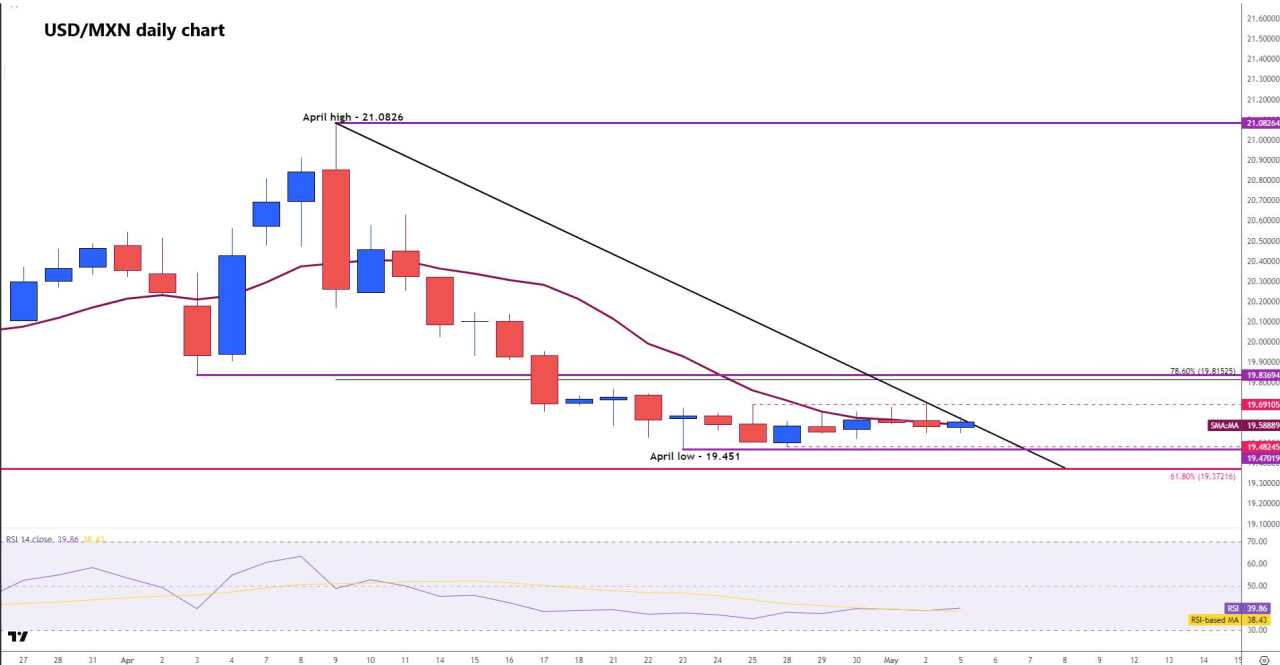- The Mexican Peso holds steady despite rising political tension between Mexico and the United States.
- Markets are watching the Federal Reserve and the Bank of Mexico for policy direction.
- The USD/MXN exchange rate tests trendline resistance.
The Mexican Peso (MXN) remains resilient against the US Dollar (USD) in Monday’s European session despite rising tensions over the weekend between Mexican President Claudia Sheinbaum and US President Donald Trump regarding a rejected proposal to deploy American troops in Mexico.
Fresh signs of slowing momentum in the US economy emerged Monday as the S&P Global US Composite Purchasing Managers Index (PMI) came in at 50.6 for April, down from 53.5 in March and below both the flash estimate (51.2) and market consensus (51.4). The reading, which captures activity across both the manufacturing and services sectors, reinforces concerns that the US economy is cooling more rapidly than expected.
With the USD/MXN exchange rate trading at 19.617, 0.17% higher from Friday’s close at the time of writing, markets remain focused on upcoming US economic data, Federal Reserve interest rate expectations, and the broader risk environment for signs of the next potential catalyst that could drive the emerging market (EM) currency pair out of its recent range.
Over the weekend, Reuters reported that Mexican President Claudia Sheinbaum had turned down an offer from US President Donald Trump to allow US troops into Mexico to combat drug trafficking. Speaking at a public event in Texcoco, Sheinbaum reiterated Mexico’s position on sovereignty, stating, “We can work together, but you in your territory and us in ours.” On Sunday, Trump confirmed the proposal, calling cartel violence a major threat and referring to drug gangs as “horrible people.”
Mexican Peso steady as geopolitics and central bank signals shape USD/MXN
While the exchange highlights long-standing sensitivities between the two nations, the Peso’s muted response suggests investors are prioritising economic fundamentals, particularly monetary policy, over political noise.
The Mexican Peso remains highly sensitive to shifts in global risk sentiment and developments in the United States, which accounts for nearly 80% of Mexico’s exports. As such, the direction of the USD/MXN pair is being shaped primarily by diverging interest rate expectations between the US Federal Reserve (Fed) and the Bank of Mexico (Banxico), alongside broader macroeconomic signals.
This week, market attention is firmly fixed on the upcoming Fed interest rate decision, scheduled for Wednesday, May 7. While the Federal Open Market Committee (FOMC) is widely expected to hold the federal funds rate at 4.25%, the key focus for investors will be the messaging that accompanies the decision. Specifically, the tone of Fed Chair Jerome Powell’s post-meeting press conference will be critical in shaping expectations about the path of US interest rates in the second half of the year.
For the USD/MXN pair, any indication that the Fed may begin easing policy sooner than anticipated could shift capital flows, reduce the yield advantage of the US Dollar, and offer renewed support to the Mexican Peso. Conversely, a more cautious or data-dependent stance may reinforce existing range-bound conditions, keeping the pair sensitive to incremental shifts in economic data and central bank communication.
Daily digest movers: Interest rates and economic outlook remain critical for USD/MXN
- According to the CME FedWatch Tool, markets are pricing in a 25-basis-point rate cut in July, as signs of softening US growth increase. A dovish tone from Powell this week could weigh on the US Dollar and support EM currencies like the Mexican Peso.
- Despite Friday’s better-than-expected Nonfarm Payrolls (NFP) report, which showed strong job creation, stable unemployment, and rising Average Hourly Earnings, the US Dollar failed to gain traction, highlighting market caution around the timing of future rate moves.
- Banxico is scheduled to meet on May 15, following two consecutive 50-basis-point rate cuts that brought the benchmark rate to 9.00%. With inflation easing and growth subdued, markets expect another cut, though Banxico has signaled a cautious, data-driven approach.
- The Mexican economy grew 0.2% QoQ in Q1 2025, narrowly avoiding a technical recession. Gains were concentrated in agriculture and mining, while manufacturing contracted and services stagnated.
- The reintroduction of US tariffs on key Mexican exports, including vehicles and metals, has added pressure to Mexico’s external sector and may weigh on growth and foreign investment in the months ahead.
Global uncertainties, including slowing international demand, volatile commodity prices, and potential shifts in US trade or immigration policy, pose additional risks to the Peso and investor confidence in emerging markets.
Peso steady as USD/MXN stalls under descending trendline
From a technical standpoint, USD/MXN remains in a tight consolidation range just below the 10-day Simple Moving Average (SMA) at 19.5864 as the pair struggles to break free from a well-defined descending channel.
The Fibonacci retracement is drawn from the April high of 21.0826 to the April low of 19.451, establishing a clear structure for potential reversal or continuation. The pair is currently testing the 100.0% Fibonacci placeholder at 19.4701, which has served as solid support in recent sessions.
A sustained break below this zone could expose the 61.8% Fibonacci retracement level of the 2024 - 2025 move at 19.3721, opening further downside.
On the upside, resistance is seen first at the 10-day SMA and then at 19.6910, with stronger resistance aligned near 19.8152 (78.6% Fibo Retracement). A descending trendline from the April peak continues to cap recovery attempts.
Meanwhile, the Relative Strength Index (RSI) remains subdued below 40, indicating that bearish momentum is still in place. Although a Hammer candlestick appeared on April 24, it has not yet triggered any meaningful bullish follow-through, keeping the near-term bias tilted cautiously lower unless the pair breaks above descending trendline resistance.
USD/MXN daily chart

Mexican Peso FAQs
The Mexican Peso (MXN) is the most traded currency among its Latin American peers. Its value is broadly determined by the performance of the Mexican economy, the country’s central bank’s policy, the amount of foreign investment in the country and even the levels of remittances sent by Mexicans who live abroad, particularly in the United States. Geopolitical trends can also move MXN: for example, the process of nearshoring – or the decision by some firms to relocate manufacturing capacity and supply chains closer to their home countries – is also seen as a catalyst for the Mexican currency as the country is considered a key manufacturing hub in the American continent. Another catalyst for MXN is Oil prices as Mexico is a key exporter of the commodity.
The main objective of Mexico’s central bank, also known as Banxico, is to maintain inflation at low and stable levels (at or close to its target of 3%, the midpoint in a tolerance band of between 2% and 4%). To this end, the bank sets an appropriate level of interest rates. When inflation is too high, Banxico will attempt to tame it by raising interest rates, making it more expensive for households and businesses to borrow money, thus cooling demand and the overall economy. Higher interest rates are generally positive for the Mexican Peso (MXN) as they lead to higher yields, making the country a more attractive place for investors. On the contrary, lower interest rates tend to weaken MXN.
Macroeconomic data releases are key to assess the state of the economy and can have an impact on the Mexican Peso (MXN) valuation. A strong Mexican economy, based on high economic growth, low unemployment and high confidence is good for MXN. Not only does it attract more foreign investment but it may encourage the Bank of Mexico (Banxico) to increase interest rates, particularly if this strength comes together with elevated inflation. However, if economic data is weak, MXN is likely to depreciate.
As an emerging-market currency, the Mexican Peso (MXN) tends to strive during risk-on periods, or when investors perceive that broader market risks are low and thus are eager to engage with investments that carry a higher risk. Conversely, MXN tends to weaken at times of market turbulence or economic uncertainty as investors tend to sell higher-risk assets and flee to the more-stable safe havens.
Được in lại từ FXStreet_id, bản quyền được giữ lại bởi tác giả gốc.
Tuyên bố miễn trừ trách nhiệm: Quan điểm được trình bày hoàn toàn là của tác giả và không đại diện cho quan điểm chính thức của Followme. Followme không chịu trách nhiệm về tính chính xác, đầy đủ hoặc độ tin cậy của thông tin được cung cấp và không chịu trách nhiệm cho bất kỳ hành động nào được thực hiện dựa trên nội dung, trừ khi được nêu rõ bằng văn bản.


Tải thất bại ()